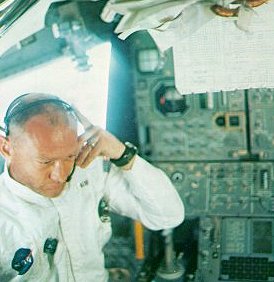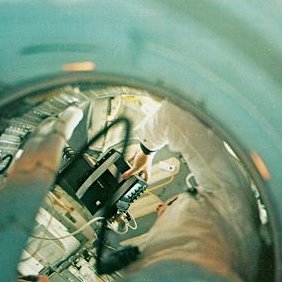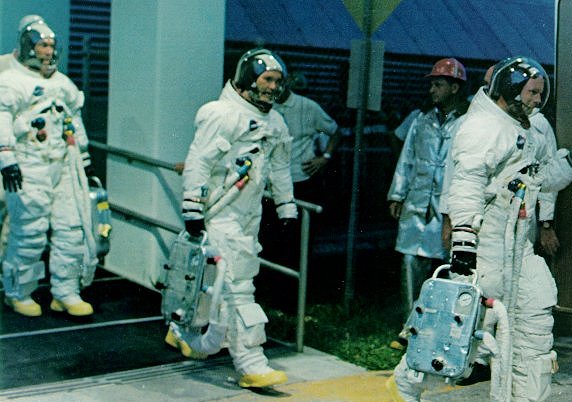Apollo Expeditions to the Moon
THE MOST AWESOME SPHERE
COLLINS: Day 4 has a decidedly different feel to it. Instead
of nine hours' sleep, I get seven - and fitful ones at that.
Despite our concentrated effort to conserve our energy on the way
to the Moon, the pressure is overtaking us (or me at least), and
I feel that all of us are aware that the honeymoon is over and we
are about to lay our little pink bodies on the line. Our first
shock comes as we stop our spinning motion and swing ourselves
around so as to bring the Moon into view. We have not been able
to see the Moon for nearly a day now, and the change is
electrifying. The Moon I have known all my life, that two-dimensional
small yellow disk in the sky, has gone away
somewhere, to be replaced by the most awesome sphere I have ever
seen. To begin with it is huge, completely filling our window.
Second, it is three-dimensional. The belly of it bulges out
toward us in such a pronounced fashion that I almost feel I can
reach out and touch it. To add to the dramatic effect, we can see
the stars again. We are in the shadow of the Moon now, and the
elusive stars have reappeared.
| | |
Striding confidently toward the transfer
van that will carry them to the launch pad, Apollo 11
Commander Armstrong leads Collins and Aldrin
past well-wishers at the start of their historic voyage.
Since they are suited up with helmets in place,
they carry portable breathing and cooling systems
until they can plug into the environmental-control
systems aboard their spacecraft.
|
As we ease around on the left side of the Moon, I marvel
again at the precision of our path. We have missed hitting the
Moon by a paltry 300 nautical miles, at a distance of nearly a
quarter of a million miles from Earth, and don't forget that the
Moon is a moving target and that we are racing through the sky
just ahead of its leading edge. When we launched the other day
the Moon was nowhere near where it is now; it was some 40 degrees
of are, or nearly 200,000 miles, behind where it is now, and yet
those big computers in the basement in Houston didn't even
whimper but belched out super-accurate predictions.
As we pass behind the Moon, we have just over eight minutes
to go before the burn. We are super-careful now, checking and
rechecking each step several times. When the moment finally
arrives, the big engine instantly springs into action and
reassuringly plasters us back in our seats. The acceleration is
only a fraction of one G but it feels good nonetheless. For six
minutes we sit there peering intent as hawks at our instrument
panel, scanning the important dials and gauges, making sure that
the proper thing is being done to us. When the engine shuts down,
we discuss the matter with our computer and I read out the
results: "Minus one, plus one, plus one." The accuracy of the
overall system is phenomenal: out of a total of nearly three
thousand feet per second, we have velocity errors in our body
axis coordinate system of only a tenth of one foot per second in
each of the three directions. That is one accurate burn, and even
Neil acknowledges the fact.

|
During the cruise phase there was less work and less
tension, although housekeeping and navigational
duties still had to be done. Here Aldrin in the lunar
module listens to numbers from Houston.
|

|
The TV camera with its monitor taped to it was also fired up
when work permitted to send back to Earth imagery of itself
and of the Moon, as well as homey details in Columbia. TV
imagery was good, though poorer than an later missions.
|
ALDRIN: The second burn to place us in closer circular orbit
of the Moon, the orbit from which Neil and I would separate from
the Columbia and continue on to the Moon, was critically
important. It had to be made in exactly the right place and for
exactly the correct length of time. If we overburned for as
little as two seconds we'd be on an impact course for the other
side of the Moon. Through a complicated and detailed system of
checks and balances, both in Houston and in lunar orbit, plus
star checks and detailed platform alignments, two hours after our
first lunar orbit we made our second burn, in an atmosphere of
nervous and intense concentration. It, too, worked perfectly.
|



